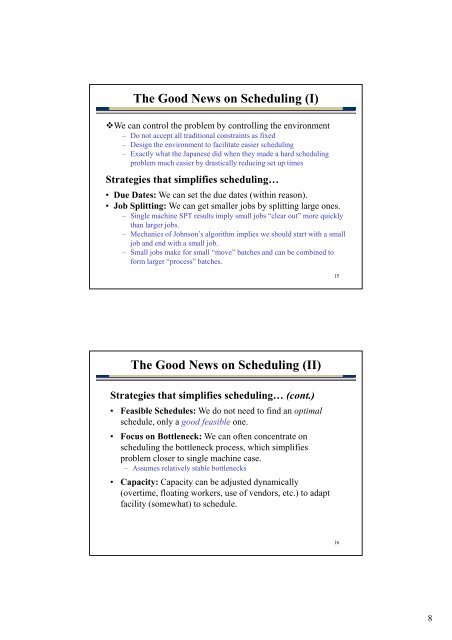Production Scheduling Nahmias, Chapter 8 ( D t lj l i ) (sv ...
Production Scheduling Nahmias, Chapter 8 ( D t lj l i ) (sv ...
Production Scheduling Nahmias, Chapter 8 ( D t lj l i ) (sv ...
Create successful ePaper yourself
Turn your PDF publications into a flip-book with our unique Google optimized e-Paper software.
The Good News on <strong>Scheduling</strong> (I)<br />
�We can control the problem by controlling the environment<br />
– Do not accept all traditional constraints as fixed<br />
– Design the environment to facilitate easier scheduling<br />
– EExactly tl what h tth the Japanese J did when h they th made d a hard h dscheduling h d li<br />
problem much easier by drastically reducing set up times<br />
Strategies that simplifies scheduling…<br />
• Due Dates: We can set the due dates (within reason).<br />
• Job Splitting: We can get smaller jobs by splitting large ones.<br />
– Single machine SPT results imply small jobs “clear out” more quickly<br />
than larger jobs.<br />
– Mechanics of Johnson’s algorithm implies we should start with a small<br />
job and end with a small job.<br />
– Small jobs make for small “move” batches and can be combined to<br />
form larger “process” batches.<br />
The Good News on <strong>Scheduling</strong> (II)<br />
Strategies that simplifies scheduling… (cont.)<br />
• Feasible Schedules: We do not need to find an optimal<br />
schedule, hdl only l a good dffeasible iblone.<br />
• Focus on Bottleneck: We can often concentrate on<br />
scheduling the bottleneck process, which simplifies<br />
problem closer to single machine case.<br />
– Assumes relatively stable bottlenecks<br />
• Capacity: Capacity can be adjusted dynamically<br />
(overtime, floating workers, use of vendors, etc.) to adapt<br />
facility (somewhat) to schedule.<br />
15<br />
16<br />
8







